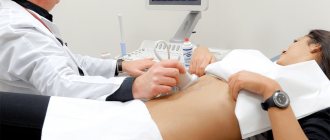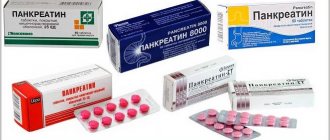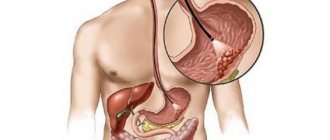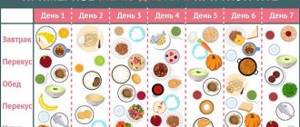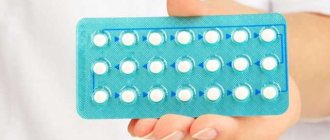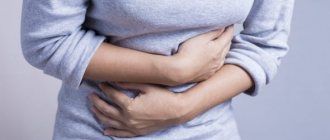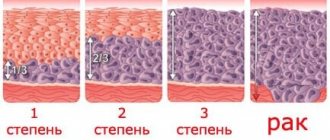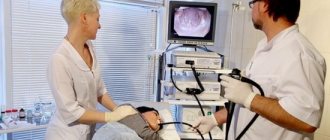Decoding concepts
Both methods are carried out with a medical device - a gastroscope, which displays the condition of the mucous membrane through the lens. During the examination, the doctor may remove a small piece of tissue for microscopic examination.
Fibergastroscope
To understand the differences between each method, let’s decipher their names:
- FGS is fibrogastroscopy. Translated from Greek: “gaster - stomach”, “skopeo - look”. That is, this research method only involves studying the gastric mucosa and assessing its condition to make a diagnosis. The prefix “fibro-” translates as “fiber” and symbolizes the long gastroscope probe that penetrates the esophagus.
- FGDS stands for fibrogastroduodenoscopy. Here in the middle of the word we see “gaster - stomach” and “duodenum - duodenum”. That is, during the examination, the gastroscope probe first assesses the condition of the stomach, and then penetrates further along the digestive tract into the initial section of the small intestine - the duodenum.
In terms of technique FGDS is a more complex method ; it is prescribed when a comprehensive assessment of the initial third of the digestive tract is necessary.
FGDS: evaluation of results
Fibrogastroduodenoscopy evaluates the patency of the upper parts of the gastrointestinal tract:
- Narrowing of the esophagus;
- Scarring;
- Changes in the functioning of the cardiac sphincter;
- Deformations of the mucous membrane;
- Inflammatory processes;
- Presence of areas of atypical epithelium;
- Refluxes (backflow of food masses);
- Chronic gastritis;
- Ulcerative defects of the stomach;
- Hiatal hernia;
- Gastric polyps;
- Benign and malignant tumors.
When performing fibrogastroduodenoscopy, a piece of tissue should be taken for histological examination. The material is sent to the histology laboratory for microscopic seeding.
During a study conducted by a pathologist, the epithelium is taken for atypical cells. Tissues quickly divide and become the basis for the development of tumor proliferation.
Histological examination also studies the cellular structure of the tumor and analyzes the type of tumor. A negative result of the procedure does not always indicate the absence of a pathological formation.
FGDS, when combined with a biopsy, plays a decisive role in surgical or conservative treatment. The type of operation is critical for malignant tumors identified by histological examination.
Patients with gastrointestinal tract abnormalities have a high incidence of hepatobiliary system defects. Identification of phenotypic characteristics allows for targeted examination to determine defects and developmental anomalies.
Preventive measures with defects and anomalies of development aimed at eliminating the inflammatory process should be planned taking into account sonographic signs: restoration of gastrointestinal motility, normalization of bile properties, correction of autonomic disorders, rate of elimination of chronic lesions.
- Elimination of esophageal stenosis;
- Elimination of bleeding;
- Excision of polyps;
- Normalization of bleeding in gastric ulcers;
- Applying the medicine to the injury site.
FGDS is a procedure that allows you to study the condition of the gastrointestinal tract. It is effective for diagnosing both early and late pathological conditions.
FGDS is a medical procedure that examines the upper part of the esophagus, stomach and duodenum. It is carried out to assess the condition of these organs, as well as their contractile properties. In addition to research, tests can also be collected that allow the doctor to fully determine the picture of the disease.
This examination is one of the most accurate, and therefore the most common. Carrying out FGDS is simply necessary to identify diseases such as stomach ulcers or cancer. It is also prescribed in cases where the patient experiences symptoms such as nausea, accompanied by painful and frequent vomiting, and severe pain in the stomach area.
Regurgitation during FGDS is normal
The FGDS examination takes place in several stages:
- First, the patient’s pharynx and oral cavity are treated with a special antiseptic. This is necessary in order to reduce pain and other negative effects that occur when swallowing the device. If you have ever had various allergic reactions to medications, you should immediately inform your doctor.
- 5-10 minutes after treatment, the subject clamps the mouthpiece in his mouth, which is necessary for complete passage of air into the lungs and to prevent mechanical damage to the device.
- Now, through a mouthpiece, a special device is inserted into the oral cavity, stomach, esophagus or duodenum, which is a thin elastic probe with a flashlight at the end.
The thickness of this device is approximately 1 cm, and it is made of optical fiber. Carrying out such an examination takes about 10 minutes, but if it is necessary to take cell particles for additional analysis, the process may take a little longer.
How is it carried out?
- You can read how to minimize discomfort here.
- Learn about breathing techniques during the procedure here.
- You can also always use sedation or anesthesia.
- Or alternative diagnostic methods.
For the patient, there is no noticeable difference between FGS and FGDS; the differences lie in the depth of penetration of the gastroscope and the time during which the study is carried out.
The procedure consists of the following steps:
- Pain relief - the throat is irrigated with lidocaine solution. This allows you to reduce gagging and discomfort during the passage of the probe.
- The patient lies on his left side - this position facilitates the passage of the tip. The stomach has a left-sided bend; in this position, nothing interferes with the probe. For convenience, a cushion is placed under the waist, and a container for saliva is placed near the mouth.
- Insertion of the probe - the patient swallows the tip, then the doctor slowly moves it along the esophagus and into the stomach. The specialist takes pictures, takes scrapings or material for research. If an FGDS is performed, the doctor then penetrates the duodenum and repeats similar manipulations.
The gastroscope tube is designed in such a way that the doctor can change the direction of the tip. This allows you to move easily and unhindered through the gastric tract without injuring the mucous membrane . On the working part there is a flashlight for illumination, special nozzles that pump water or air to inflate the cavities and clean the lens. The probe is removed in the reverse order, slowly and carefully.
Reference
During the procedures, it is strictly forbidden to try to talk, make movements, cough, or clench your jaw - this can damage the mucous membrane! Experts recommend trying to relax, breathing slowly and deeply.
What is FGDS
The name of the procedure is deciphered as follows:
- The prefix “fibro” means the characteristics of the probe used for diagnostics. It consists of optical fiber. Recently, a videoscope has also been used. It allows you to display a video image of the digestive tract organs on the monitor.
- The “gastro” part of the word means that during this procedure the stomach is examined.
- The “duodeno” part of the word means that the duodenum, the beginning of the intestine, is being examined.
- The ending of the word “scopy” means that the doctor uses a probe to examine the abdominal organs.
Often this procedure is also called fibroesophagogastroduodenoscopy. This means that the examination involves examining the esophagus.
What is the difference?
Let us note the main differences between gastroscopy of the stomach and FGDS - we present them in the table below.
| Criterion | FGS | FGDS |
| Scope of study | Only stomach | Stomach and duodenum |
| Discomfort during the procedure | Moderate | May be more pronounced |
| Possibility of complications | Less | More |
| Comprehensive assessment of the initial part of the digestive tract | Absent | Present |
| Volume of readings | Small | Wide |
During FGDS, the device passes through the pyloric sphincter into the duodenal bulb, which increases discomfort during the procedure.
With FGDS, it is possible to conduct a comprehensive assessment of the mucous membrane of the stomach and duodenum. Such a comparison expands diagnostic capabilities and makes the technique more valuable.
Contraindications to FGS
Despite the fact that FGS is a fairly informative procedure, it has a number of contraindications:
- recent heart attack and stroke;
- high blood pressure;
- bleeding disorders (the endoscope can damage the wall of the gastrointestinal tract, which can lead to severe bleeding);
- asthma (the procedure may trigger asthma attacks);
- mental disorders and diseases (panic attacks and motor agitation can damage the walls of the mucous membrane).
Indications
Both methods are prescribed depending on the patient’s complaints and based on a doctor’s examination. If suspicions are limited only to damage to the stomach, FGS is performed. FGDS is relevant in cases where there is a risk of involvement of the duodenum, gallbladder and pancreas in the pathology. We provide basic information about the indications in the table below.
| Indications for FGS | Indications for FGDS |
| · bloody vomiting; epigastric pain; · belching rotten; · heartburn; · dyspeptic disorders; · losing weight with a normal appetite; · control of treatment procedures. | · all indications for FGS; Darkening of the stool, which indicates intestinal bleeding; · suspicion of duodenal ulcer, oncology; · signs of damage to the biliary tract, pancreas and liver. |
Let us note the features of the indications for both procedures:
- FGS is prescribed when the doctor is sure that only the stomach is affected. This procedure will be faster and will cause the patient a minimum of discomfort, and when examined in a private clinic, it will also save money.
- FGDS is important for lesions of the duodenum. It is also prescribed for suspected diseases of the pancreas, liver and gall bladder. The doctor can judge the state of their work by the nature of the discharge and the results of changes in the papillary zone.
Indications for the procedure
In modern medicine, FGDS remains the most clear and highly informative diagnostic method.
During endoscopic intervention, in addition to the standard list of manipulations, there is the possibility of taking a biopsy from the affected area, irrigating the walls of the organ with a medicinal product, and performing simple surgical operations.
Despite the relative ease of implementation, medical manipulations cause discomfort and unpleasant sensations, and therefore are strictly regulated by indications.
- Pain in the stomach that appears immediately after finishing a meal and indicates the development of gastritis or peptic ulcer.
- Rapid weight loss in a short time.
- Decreased or complete absence of appetite.
- Frequent and prolonged heartburn.
- Bloating.
- Belching of unknown etiology.
- Pains called hunger pains, which do not appear immediately, but 3-4 hours after eating, and indicate the development of duodenitis.
- A decrease in hemoglobin, indicating the likelihood of internal bleeding.
Diagnosis can be carried out as a preparatory stage for surgical treatment.
What do the studies diagnose?
FGDS diagnoses the conditions listed above, and additionally identifies diseases of the duodenum in the form of ulcerative lesions and various injuries . Based on a visual examination, the functioning of the biliary system and pancreas is assessed.
FGDS diagnostic
The FGDS procedure will help make a diagnosis.
The gastroenterologist also talks about the need to perform an FGDS procedure in a situation where you need to see what the mucous membrane of the stomach, the walls of the esophagus, and the duodenum look like.
Without the FGDS procedure, it is impossible to clearly make a diagnosis, and therefore it is not possible to prescribe treatment. This procedure must be completed in order to identify diseases with symptoms:
- Inflammatory conditions of the walls of the stomach, which also include acute and chronic gastritis with varying acidity in the stomach;
- Inflammatory processes of the duodenum of various origins and degrees of complications;
- Esophagitis;
- Reflux esophagitis;
- The presence of ulcers on the walls of the stomach, as well as the duodenum;
- The likelihood of developing tumors of various origins in the intestines.
Read: Gastroscopy under anesthesia: features and contraindications
This procedure must also be carried out for prevention, so as not to miss serious changes in the functioning of organs. The people most at risk are:
- Those who are over 40 years old or people who are constantly bothered by pain in this area;
- People who are genetically prone to various serious diseases, including cancer, chronic diseases, or simply often consume harmful foods, alcohol, and other things.
- This procedure is also indicated for those who suffer from nausea, constant heartburn, belching and other unpleasant moments.
- People who have had gastric surgery in the past.
- People who have previously taken glucocorticosteroids or non-steroidal drugs that have an anti-inflammatory effect.
If the patient develops gastroesophageal reflux disease.
Preparation
Before the examination, you should pay attention to your diet - since the procedure is unpleasant and can cause vomiting, you will need to follow a small diet.
It is important to give up bad habits and consult a doctor. During the initial examination, you can study in detail the advice of specialists and the rules of conduct during procedures. Detailed article about preparing for FGDS at this link.
FGDS - when not to do it
The FGDS procedure also has contraindications.
This examination cannot be carried out if the patient has a sore throat or has an acute respiratory disease. When is it necessary to sign up for an FGDS procedure:
- Body temperature remains at 38 degrees Celsius.
- Constant nausea, as well as vomiting, with which blood clots come out (in this situation, the color resembles dark chocolate).
- Defecation is difficult, and the stake is black (that is, there is a trace of blood in it).
- My stomach hurts all the time.
All this suggests that some abnormalities are developing in the body. To find out, you need to urgently visit a doctor who will prescribe this procedure.
Read along with this article:
- Preparation for FGDS of the stomach: features of the procedure required...
- FGDS of the stomach: preparation for the procedure
- Research was prescribed: FGDS - what is it?
- Fibrogastroduodenoscopy as a research method...
- How FGDS is done: preparation and conduct of the procedure
- How is an X-ray of the intestine done with contrast (with barium)
- What can be seen with magnetic resonance imaging of the stomach
- Fibrogastroscopy of the stomach: when is it necessary and how is it performed?
- Gastroscopy under anesthesia: features and contraindications
Alternative Methods
Sometimes situations arise in which the use of a gastroscope is impossible - due to intolerance to discomfort, the presence of contraindications and other reasons.
In such cases, additional methods may be prescribed. Let's display them in table form and compare them with gastroscopy - note the pros and cons.
| Research method | Advantage | Flaw |
| Ultrasound | Painless examination, minimal contraindications | The mucous membrane is displayed worse than with gastroscopy |
| MRI | Painless examination, minimal contraindications | It is impossible to conduct a study if you have claustrophobia, pacemakers or metal implants |
| CT with contrast | The procedure is faster, less discomfort | The study is accompanied by radiation |
| Using the video capsule | Painless examination, minimal contraindications | The quality of the images depends on intestinal motility; there is no possibility of directed examination. |
Important
safety for the patient’s health and information content are primarily taken into account . Sometimes it is better to endure discomfort for the sake of an accurate diagnosis than to treat complications later.
Decoding the results
Normally, the gastric mucosa is pale pink, smooth, covered with mucus and without defects. Acidity in the body and fundus is 1.5-2.3, in the pyloric region 4.6-7.3, and in the esophagus - 5.6-7.8. The test for Helicobacter is negative. There are no deformations, narrowing of the lumen or neoplasms. On the greater curvature, transverse folds are clearly visible. There is no bile in gastric juice. Regular peristaltic movements of the walls are also visible. An example of the norm can be seen in the following photo.
All detected deviations are recorded in the results by the endoscopist immediately after the examination. They are handed out to the patient or doctor, and are also sent to the specified email address.
Which doctor should I contact after the study?
If gastritis, ulcers, duodenogastric reflux, or dilation of the esophageal veins are detected, the patient should consult a gastroenterologist, general practitioner or family doctor. In case of hemorrhage, congenital malformations or severe deformation of the organ - see a surgeon, and in case of neoplasms - see an oncologist.
What can gastroscopy of the stomach do?
During the procedures, it is possible not only to identify various pathologies of the digestive system, but also to carry out therapeutic manipulations. Modern gastroscopes are equipped with useful functions and allow you to do without surgery in some cases.
With gastroscopy you can:
Taking a biopsy during FGDS or FGS
- Removing polyps is a potential cancer threat. If the doctor discovers these tumors during the procedures, they are cauterized using a gastroscope.
- To carry out bougienage is an expansion of the narrowed esophagus. The device moves deformed shells apart and restores patency.
- Spray the medicine - a gastroscope is capable of spraying medicines over a specific area of the mucosa. This option is widely used to eliminate hidden bleeding.
- Take a biopsy to determine the bacteria Helicobacter pylori or to check for tumors.
- Take a stomach acid test.
What diseases does FGDS detect?
What does gastroscopy show? With a thorough examination using modern equipment and with proper adherence to the protocol, the following pathologies can be identified in the patient:
- pathological disorders in the structure of the mucous epithelium in the form of erosions, small ulcers and polyps;
- gastritis and peptic ulcer;
- tumor neoplasms;
- colitis and cholecystitis;
- protrusions in the walls of the esophagus called diverticula;
- stenosis of the examined organ and the presence of scars;
- partial or complete obstruction of the upper segment of the gastrointestinal tract;
- reflux of various etiologies;
- deterioration of the esophageal valves;
- stomach cancer.
The purposes of fibrogastroduodenoscopy are quite varied. Their entire range is displayed in the table below.
| Types of pathology | Possible events |
| Polyposis | Detection at any stage with subsequent removal |
| Ulcers | Determination of the severity of the lesion, the inflammatory process. Stop bleeding (if any) Administer medication |
| Phlebeurysm | Detecting hidden bleeding of the esophageal veins and applying clips to stop it |
| Inflammation of the esophageal mucosa | Determining the form of esophagitis in order to select the correct treatment tactics |
| Inflammation of the gastric mucosa | Assessing the condition of the epithelial layer, the presence of edema and redness, identifying fold hypertrophy |
| Inflammation of the duodenal mucosa | Identification of pathologies to clarify the diagnosis Drawing up a treatment regimen |
| Inflammation of the colon mucosa | A thorough examination followed by taking a biopsy sample |
| Gastroesophageal reflux | Recovery complete the picture of the disease followed by the choice of treatment algorithm |
| Hidden bleeding | Detecting condition and applying clips to stop |
Contraindications
Before conducting a study, it is important to take into account the limitations - ignoring contraindications is dangerous for the health, and sometimes even for the life of the patient.
We list when gastroscopy cannot be done:
- problems with blood pressure are noted;
- history of stroke or heart attack;
- there is a risk of bleeding ;
- the patient has bronchial asthma ;
- mental disorders are noted.
FGDS - how to prepare
Examination of the walls of the stomach includes preparatory measures. Within a few days, you need to completely stop taking various medications.
But according to the doctor's instructions, some can be left. 12 hours before the procedure, you must not eat or drink liquids.
This is necessary so that the person does not develop a gag reflex during the procedure, which will complicate the procedure. If the patient has an allergy, it is necessary to notify the doctor in advance. Otherwise, complications may arise that may have unpleasant consequences.
Preparing for the study
In order for the doctor to conduct an FGDS normally, it will be necessary to prepare for the diagnosis. Preparation not only makes the doctor’s work easier, but also the patient will experience less discomfort, and the procedure itself will go faster. The general preparatory rules are as follows:
- How to prepare for FGDS of the stomach
FGDS is performed only on an empty stomach. The patient needs to have dinner on the eve of the procedure no later than 8 pm, and the study will have to be carried out in the first half of the day. If the procedure is scheduled for the second half of the day, then you can have a light breakfast, but there should be 8 hours before the start of the FGDS.
- On the day of the FGDS, it is forbidden to even drink water. The interval between the last drink and intake should be 5 hours.
- 7 days before the start, you will need to remove from your diet all dishes and products that can irritate the stomach and esophagus. It is necessary to give up alcohol, cigarettes and try to lead a healthy lifestyle. All this allows you to achieve normal stomach acidity.
- There are certain medications that negatively affect the gastrointestinal tract and can distort the data obtained on FGDS. In order to avoid troubles and the doctor can establish the correct diagnosis, it is recommended to stop using the tablets or replace them with other medications, as recommended by the attending physician.
By adhering to these simple rules, you can prepare for an FGDS of the stomach on your own, and do the study quickly and with minimal discomfort.
Feelings after FGDS
After the procedure, the following manifestations are possible:
- discomfort in the stomach;
- feeling of nausea;
- a sore throat.
The last point is due to the fact that during FGDS, slight trauma to the tonsils is possible, so the patient may feel the same as during a sore throat. To quickly get rid of an unpleasant symptom, you need to eat soft food, eat a small amount of honey before going to bed at night and use lollipops.
In case of severe discomfort, it is recommended to drink a teaspoon of sea buckthorn oil before eating. It should be noted that the use of general anesthesia entails additional symptoms.
